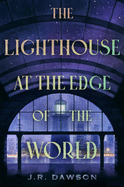
J.R. Dawson's second novel, The Lighthouse at the Edge of the World, is an atmospheric and enthralling story of grief, love, and choice.
Charlie Connor is mourning the loss of her sister, Sam, who died in a mass shooting, and trying to care for her father, who has withdrawn into himself. Charlie started seeing ghosts after Sam died, and she has spent the past six months carrying sheet music of an unfinished song Sam composed all over Chicago in an attempt to draw out her sister's ghost. Nera Harosen lives in the Station, a midway point situated between the city and the lake for souls on their way to the afterlife. She spends her days helping her father keep malicious spirits known as Haunts out of the Station while he ferries souls across the lake. When Charlie follows the sound of her sister's song and discovers the Station, both women's realities are shattered. Nera becomes aware of her corporeal body in ways she never imagined possible, but she would have to forfeit her duty to follow her heart and live with Charlie. Charlie's piano playing strengthens the flickering Station light, but she would have to abandon her life to help keep it burning bright. As they each pursue their goals and even gain sympathy for the Haunts, long-hidden secrets threaten to destroy their worlds.
The novel's sapphic romance develops alongside the slowly unfolding plot that draws on Greek and Jewish mythology and grapples with themes of loss, duty, and marginalized identities. Dawson (The First Bright Thing) creates an eerie, quiet atmosphere throughout, which makes the showdown scenes even more explosive. --Dainy Bernstein, freelance reviewer

